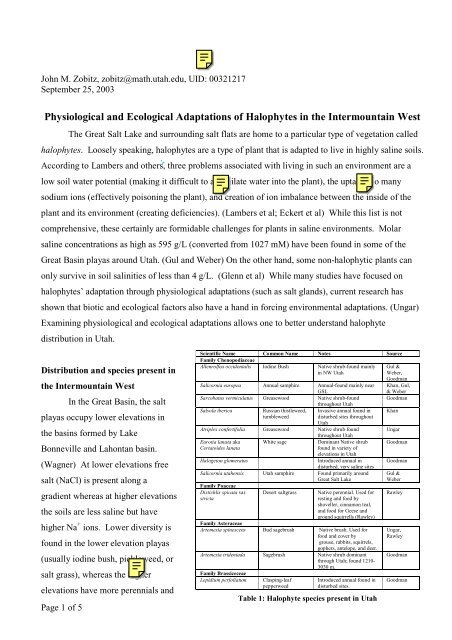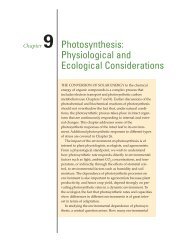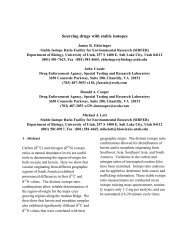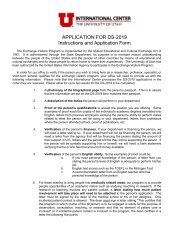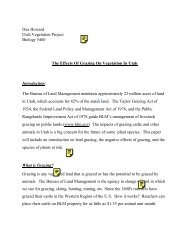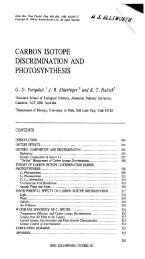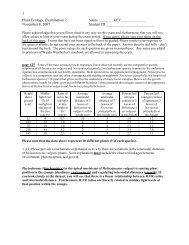Physiological and Ecological Adaptations of ... - Ehleringer net
Physiological and Ecological Adaptations of ... - Ehleringer net
Physiological and Ecological Adaptations of ... - Ehleringer net
You also want an ePaper? Increase the reach of your titles
YUMPU automatically turns print PDFs into web optimized ePapers that Google loves.
John M. Zobitz, zobitz@math.utah.edu, UID: 00321217September 25, 2003<strong>Physiological</strong> <strong>and</strong> <strong>Ecological</strong> <strong>Adaptations</strong> <strong>of</strong> Halophytes in the Intermountain WestThe Great Salt Lake <strong>and</strong> surrounding salt flats are home to a particular type <strong>of</strong> vegetation calledhalophytes. Loosely speaking, halophytes are a type <strong>of</strong> plant that is adapted to live in highly saline soils.According to Lambers <strong>and</strong> others, three problems associated with living in such an environment are alow soil water potential (making it difficult to assimilate water into the plant), the uptake too manysodium ions (effectively poisoning the plant), <strong>and</strong> creation <strong>of</strong> ion imbalance between the inside <strong>of</strong> theplant <strong>and</strong> its environment (creating deficiencies). (Lambers et al; Eckert et al) While this list is notcomprehensive, these certainly are formidable challenges for plants in saline environments. Molarsaline concentrations as high as 595 g/L (converted from 1027 mM) have been found in some <strong>of</strong> theGreat Basin playas around Utah. (Gul <strong>and</strong> Weber) On the other h<strong>and</strong>, some non-halophytic plants canonly survive in soil salinities <strong>of</strong> less than 4 g/L. (Glenn et al) While many studies have focused onhalophytes’ adaptation through physiological adaptations (such as salt gl<strong>and</strong>s), current research hasshown that biotic <strong>and</strong> ecological factors also have a h<strong>and</strong> in forcing environmental adaptations. (Ungar)Examining physiological <strong>and</strong> ecological adaptations allows one to better underst<strong>and</strong> halophytedistribution in Utah.Distribution <strong>and</strong> species present inthe Intermountain WestIn the Great Basin, the saltplayas occupy lower elevations inthe basins formed by LakeBonneville <strong>and</strong> Lahontan basin.(Wagner) At lower elevations freesalt (NaCl) is present along agradient whereas at higher elevationsthe soils are less saline but havehigher Na + ions. Lower diversity isfound in the lower elevation playas(usually iodine bush, pickleweed, orsalt grass), whereas the higherelevations have more perennials <strong>and</strong>Page 1 <strong>of</strong> 5Scientific Name Common Name Notes SourceFamily ChenopodiaceaeAllenrolfea occidentalis Iodine Bush Native shrub-found mainlyin NW UtahGul &Weber,GoodmanSalicornia europea Annual samphire Annual-found mainly nearGSLKhan, Gul,& WeberSarcobatus vermiculatus Greasewood Native shrub-foundthroughout UtahGoodmanSalsola ibericaRussian thistleweed,tumbleweedInvasive annual found indisturbed sites throughoutUtahAtriplex confertifolia Greasewood Native shrub foundthroughout UtahEurotia lanata aka White sageDominant Native shrubCertatoides lanatafound in variety <strong>of</strong>elevations in UtahHalogeton glomeratusIntroduced annual indisturbed, very saline sitesSalicornia utahensis Utah samphire Found primarily aroundGreat Salt LakeFamily PoaceaeDistichlis spicata var.strictaDesert saltgrassNative perennial. Used forresting <strong>and</strong> food byshoveller, cinnamon teal,<strong>and</strong> food for Geese <strong>and</strong>ground squirrells (Rawley)Family AsteraceaeArtemesia spinescens Bud sagebrush Native brush. Used forfood <strong>and</strong> cover bygrouse, rabbits, squirrels,gophers, antelope, <strong>and</strong> deer.Artemesia tridentada Sagebrush Native shrub dominantthrough Utah; found 1210-3030 m.Family BrassiceceaeLepidium perfoliatumClasping-leafpepperweedIntroduced annual found indisturbed sites.Table 1: Halophyte species present in UtahKhanUngarGoodmanGoodmanGul &WeberRawleyUngar,RawleyGoodmanGoodman
usually are in competition with other non-halophytic plants. (Wagner)From my literature search I came across many different <strong>and</strong> varied species <strong>of</strong> halophytes-bothinvasive <strong>and</strong> native species alike. By cross-referencing species found in literature (ones that werestudied <strong>and</strong> also just mentioned) with their corresponding entry in the Atlas <strong>of</strong> the Vascular Plants <strong>of</strong>Utah by Albee <strong>and</strong> others, I feel that I have a comprehensive listing <strong>of</strong> the majority <strong>of</strong> halophytic speciesin Table 1.<strong>Physiological</strong> adaptationsThe physical structure <strong>of</strong> halophytes has evolved to cope with increased levels <strong>of</strong> salt. It wasfound that salt affects the hydraulic permeability, transpiration, <strong>and</strong> stunts plant growth. (Gale)Interestingly enough, no connection has been foundbetween increased salt levels <strong>and</strong> a decrease inphotosynthesis. (Gale) To <strong>of</strong>fset these deleterious effectson the plant one <strong>of</strong> the many ways halophytes cope iswith salt hairs, salt gl<strong>and</strong>s (help to excrete salt), <strong>and</strong>increased succulence (helps to lower salt concentrationsin a particular area). (Ungar) Figure 1 has a diagram <strong>of</strong> asalt gl<strong>and</strong> for an Atriplex species. What thisaccomplishes for the halophyte is establishment <strong>of</strong> agradient between the physical environment <strong>and</strong> the plant,creating tolerable saline concentrations on the inside <strong>of</strong>the plant. Salt is pumped from the xylem into thevacuole, <strong>and</strong> then deposited on the leaf, giving it a whiteappearance. (Lambers et al) Other adaptations are earlier lignification (hardening) <strong>of</strong> plant tissue, <strong>and</strong>inhibition <strong>of</strong> tissue differentiation. (A. Poljak<strong>of</strong>f-Mayber) Intuitively these barriers make sense. If aplant has a lower saline concentration than its surrounding environment, ions will tend to diffuse into theplant to maintain chemical equilibrium. Thick, hardened tissue presents a greater barrier for diffusion <strong>of</strong>salts through the cellular membrane.Figure 1: Diagram <strong>of</strong> salt gl<strong>and</strong>, fromLambers et alSeed germination/Timing <strong>of</strong> dispersalExperiments <strong>of</strong> germination <strong>and</strong> seed dispersal mechanisms for halophytic plants have been welldocumented in the literature. (Gul <strong>and</strong> Weber; Khan, Gul, <strong>and</strong> Weber) The traditional approach to suchstudies is to grow seeds <strong>of</strong> various halophytes in different saline conditions <strong>and</strong> count the number <strong>of</strong>Page 2 <strong>of</strong> 5
seedlings that germinate. As noted in Gul <strong>and</strong> Weber, halophyte seeds remain viable for long periods<strong>and</strong> wait for environmental cues such as light <strong>and</strong> temperature to blossom. For the Great Basin, thiswould correspond to times <strong>of</strong> snowmelt that floods the lower areas, leading to a reduced salineconcentration in the soil. Usually such times occur during the spring-a time with increased light <strong>and</strong>warmer temperatures. Almost counter intuitively, germination studies <strong>of</strong> S. iberica <strong>and</strong> A. occidentalisindicate that germination rates decreased with increasing salinity, suggesting that there is an upperbound on saline concentrations tolerable for halophyte survival. (Gul <strong>and</strong> Weber; Khan, Gul, <strong>and</strong>Weber)Competition factorsPage 3 <strong>of</strong> 5Competition with halophytic <strong>and</strong> non-halophytic plants determines species distribution <strong>and</strong>survival in the Great Basin. In a 1991 study by Kenkel<strong>and</strong> others, three different grasses (Poa pratensis,Hordeum jubatum, <strong>and</strong> Puccinelia nuttalliana) thatvaried in their level <strong>of</strong> salt tolerance were grown incontrolled conditions as a mixture at different salinities.P. nuttalliana was the most salt tolerant whereas H.jubatum was the least salt tolerant. P. pratensis is knownto be a halophytic plant. It resulted that the meanproportional aboveground biomass <strong>of</strong> P. nuttallianaincreased with increasing salinity, whereas the other twoplants decreased in biomass. This indicates that the moresalt-tolerant plant becomes a better competitor withincreasing salinity. (Kenkel et al) See Figure 2 for theresults reproduced from the original paper.Being a halophytic <strong>and</strong> an invasive species may also confer advantages over other native plants.In a controlled greenhouse study <strong>of</strong> invasive halophytic plants <strong>and</strong> native plants to the Colorado RiverDelta, Glenn <strong>and</strong> others found that mesic species such as Salix goodingii, Populus fremontii, <strong>and</strong>Baccharis salicifolia cannot be competitive above 4 g/l NaCl concentration, whereas an invasive such asTamarix ramosissima had a maximum growth rate at 8 g/L NaCl. These findings supportedobservations <strong>and</strong> soil measurements along the Colorado River where Tamarix was dominant (NaClconcentration <strong>of</strong> 6-8 g/L) <strong>and</strong> areas where soil salinity was much lower, native species dominated.(Glenn et al)Figure 2: Aboveground biomass <strong>of</strong> 3 plantsgrown in mixture at increasing salinity.Note how the biomass <strong>of</strong> the Puccinelliaincreases with increasing salinity.
Management issuesManagement <strong>of</strong> halophytes can be divided into two areas: keeping the existing native halophyticspecies intact <strong>and</strong> preventing more salt-tolerant species from displacing native flora. As noted above inthe competition section, research indicates a trade<strong>of</strong>f between competitiveness <strong>and</strong> salt tolerance. If thedistribution <strong>of</strong> the salt playas shifts on the Great Salt Lake, perhaps decreasing the salinity <strong>of</strong> a moresaline area, then that environment would allow for more competitive, less salt-tolerant plants, to invade.Thus non-halophytic plants could exp<strong>and</strong> their area <strong>and</strong> distribution in such a scenario.In general halophytes can germinate <strong>and</strong> grow better in less saline conditions, <strong>and</strong> rely on theseasonal melt <strong>of</strong> snow to begin germination. (Zedler et al; Gul & Weber) This should be <strong>of</strong> concernsince this climate change might lead to a change in vegetation <strong>and</strong> allow for more competitive invasivespecies to dominate the l<strong>and</strong>scape, as has already been observed with saltcedar (Tamarix chinensis), aRussian invasive that has begun to dominate riparian areas. (Everitt)There has been a concerted effort in recent years to underst<strong>and</strong> the ecology <strong>and</strong> the relationshipthat salt playas <strong>and</strong> halophytes have on other animals. The Great Salt Lake is not uniformly saline withthe north arm (Gunnison Bay) being more saline than the northeastern, eastern, <strong>and</strong> southeastern shores.(Great Salt Lake Planning Team) Yet these salt playas also tend to shift seasonally but are a criticalhabitat for snow plovers <strong>and</strong> foraging areas for avocets <strong>and</strong> stilts. (Great Salt Lake Planning Team)Future decisions about development or protection <strong>of</strong> the area surrounding the Great Salt Lake must takethe whole ecosystem into consideration.In regards to restoring halophytic plants to native habitats, one <strong>of</strong> the ways to accomplish this isby transplanting seedlings into less saline environments (such as a greenhouse) until germination <strong>and</strong>then restore them to their habitat. (Zedler et al) Taking a more proactive stance, one way to combat theexpansion <strong>of</strong> halophytic invasive species from taking over riparian zones is to intentionally flood areas,allowing soil salinity to decrease so native flora can survive. (Glenn et al)Halophytes are unique plants that live in difficult conditions. Salt gl<strong>and</strong>s <strong>and</strong> hairs are a uniqueadaptation that allows them to survive where other plants cannot. As evidenced, halophytes can be boththe aggressor (as with the case <strong>of</strong> T. chinensis) as well as the victim (evidenced with plants on the saltplayas). It will take active planning <strong>and</strong> consideration to ensure 100 years from now these species are asmuch <strong>of</strong> a facet <strong>of</strong> the vegetation <strong>of</strong> the Intermountain West as they are today.Page 4 <strong>of</strong> 5
Works CitedAlbee, Beverly J., Leila M. Shultz, Sherel Goodrich. Atlas <strong>of</strong> the Vascular Plants <strong>of</strong> Utah. Salt LakeCity, UT: Utah Museum <strong>of</strong> Natural History, 1988.Everitt, B. L. “Ecology <strong>of</strong> Saltcedar-A Plea for Research.” Environmental Geology. 3:77-84, 1980.Gale, J. “Water Balance <strong>and</strong> Gas Exchange <strong>of</strong> Plants Under Saline Conditions.” in Plants in SalineEnvironments, ed by A. Poljak<strong>of</strong>f-Mayber <strong>and</strong> J. Gale. New York: Springer-Verlag. pp 165-185, 1995.Glenn, E. R. Tanner, S. Mendez, T. Kehret, D. Moore, J. Garcia, C. Valdes. “Growth rates, salttolerance, <strong>and</strong> water use characteristics <strong>of</strong> native <strong>and</strong> invasive riparian plants from the delta <strong>of</strong> theColorado River, Mexico.” Journal <strong>of</strong> Arid Environments. 40: 281-294, 1998.Goodman, P. J. “<strong>Physiological</strong> <strong>and</strong> Ecotypic <strong>Adaptations</strong> <strong>of</strong> Plants to Salt Desert Conditions in Utah.”Journal <strong>of</strong> Ecology, 61: 2. 473-494, 1973.Great Salt Lake Draft Comprehensive Management Plan. Prepared by Great Salt Lake Planning Team.Utah Department <strong>of</strong> Natural Resources. 11/3/1999.Gul, B <strong>and</strong> D. J. Weber. “Effect <strong>of</strong> salinity, lights, <strong>and</strong> temperature on germination in Allenrolfeaoccidentalis.” Canadian Journal <strong>of</strong> Botany, 77: 240-249, 1999.Khan, M. A., B. Gul, <strong>and</strong> D. J. Weber. “Seed germination in the Great Basin halophyte Salsola iberica”Canadian Journal <strong>of</strong> Botany, 80: 650-655, 2002.Kenkel, N. C, A. L. McIlraith, C. A. Burchill, G. Jones. “Competition <strong>and</strong> the response <strong>of</strong> three plantspecies to a salinity gradient.” Canadian Journal <strong>of</strong> Botany, 69: 2497-2502, 1991.Lambers, H, H. S. Chapin III, T. L. Pons. Plant <strong>Physiological</strong> Ecology. New York: Springer-Verlag,1998.Poljak<strong>of</strong>f-Mayber, A. “Morphological <strong>and</strong> Anatomical Changes in Plants as a Response to SalinityStress.” in Plants in Saline Environments, ed by A. Poljak<strong>of</strong>f-Mayber <strong>and</strong> J. Gale. New York: Springer-Verlag. pp 97-117, 1995Rawley, E. V. “Plant Life <strong>of</strong> the Great Salt Lake Study Area” in Great Salt Lake: A Scientific,Historical, <strong>and</strong> Economic Overview. ed. J. W. Gwynn. Salt Lake City, UT: Utah Geological <strong>and</strong>Mineral Survey, 1980.Ungar, I. A. “Are Biotic Factors Significant in Influencing the Distribution <strong>of</strong> Halophytes in SalineHabitats?” The Botanical Review. 176-99, April-June 1998.Wagner, F. H. 2003. Natural Ecosystems III: The Great Basin. Pp 207-239 in F. H. Wagner (ed.). RockyMountain/Great Basin Regional Climate-Change Assessment. Report for the U.S. Global ChangeResearch Program. Utah State University, Logan, UT: IV + 240 pp.Zedler, J.B., H. Morzaria-Luna, K. Ward. “The challenge <strong>of</strong> restoring vegetation on tidal, hypersalinesubstrates.” Plant <strong>and</strong> Soil. 253: 259-273, 2003.Page 5 <strong>of</strong> 5


